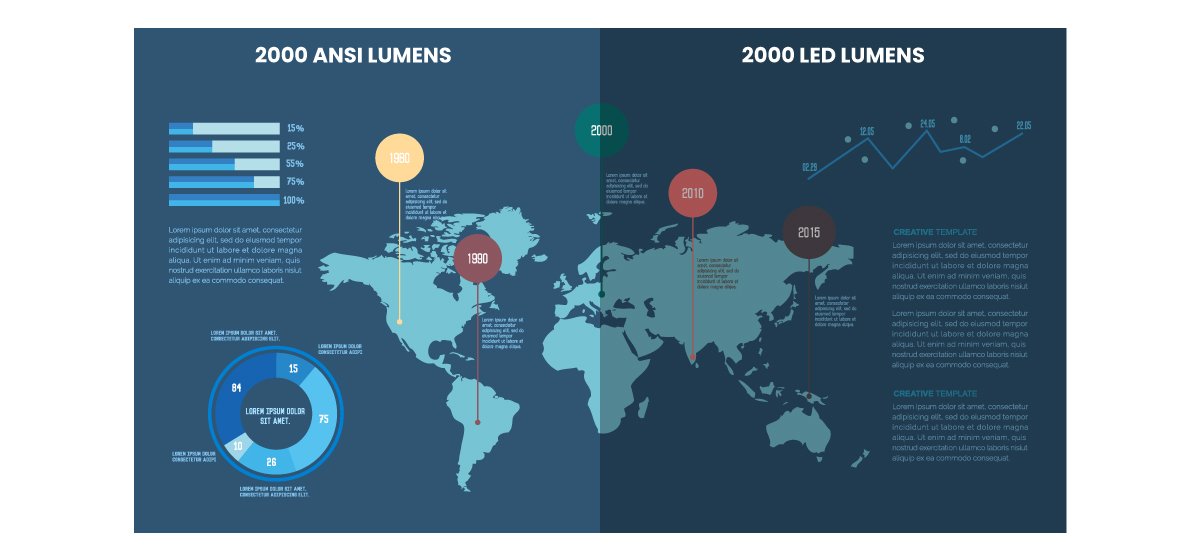Understanding the Difference Between ANSI and LED Lumens
- BenQ
- 2022-05-05
Due to the diversity of choices available in the market for electronics, the way in which product-related information is communicated has an outsized importance in determining how easily a prospective buyer is able to wade through the sea of options. One facet of this is the need for clear and consistent product specifications which would allow the buyer to make straightforward comparisons that result in well-informed decisions. For those looking for a projector and end up encountering a dizzying array of units and values in their specification fields, this can be felt particularly when it comes to brightness and the different “lumens” that are used. This is because even with an understanding of what a “lumen” is – the most basic unit of measure for the quantity of light produced by a source – a consumer may still need to be able to decipher the two most common forms of lumens that are used for projectors, ANSI lumens and LED lumens, in order to figure out whether one projector is actually brighter than another.

ANSI Lumens: What they are and how they are Calculated
The unit of measure most commonly used by the industry to express a projector’s brightness is ANSI lumens. Developed by the American National Standards Institute (ANSI), it is a unit of measure whose pervasiveness in the market is due to the industry recognizing that its precise methodology makes it the most objective measure of brightness. To calculate a projector’s brightness in ANSI lumens, the projector is first placed at a designated distance from a projection screen and then made to project a completely white screen. The screen is divided into nine equally-sized sections with center points in each section (indicated by the L values below) from which brightness readings are taken, using an illuminance meter, and then averaged. The resulting average is then multiplied by the surface area of the screen with the product of this equation equaling the projector’s brightness value in ANSI lumens.

This method of calculation, with its standard practices that utilize objective measurements from an optical instrument, is the reason for its place as the most commonly used unit in the industry. It is also because of this methodology that ANSI lumens can be considered as a measure of brightness that is free of any hint of marketing-based obfuscation, inflation, and/or misdirection, as opposed to some of the other units of brightness that are used by different brands to advertise their products.

ANSI Lumen values are calculated by dividing the screen into nine equally-sized sections with center points (L1, L2…L9) from which brightness readings are taken and averaged
LED Lumens: What they are and how they are Calculated
Whereas ANSI lumens are units that are essentially derived from the objective readings of an illuminance meter, LED lumens – a measure of brightness used by certain brands – are units of measure that also factor in the role that the human eye plays in how we judge brightness. That’s because the level of color saturation from colored lights (such as the ones used in LED projectors) can affect the way in which the human eye, due to its physiology, perceives the brightness of an image, which an illuminance meter cannot detect. This phenomenon is called the Helmholtz–Kohlrausch Effect, which states that colors that are more saturated will be perceived by the human eye as being brighter than less saturated colors that have the same objective luminance level (i.e., brightness). The implications of the H-K effect for projectors are that a projector whose color performance allows for purer, more saturated colors will produce images that are seen as being brighter than the images from a projector with the same objective brightness but less saturated colors. In essence it implies that ANSI lumens does not tell the whole story in terms of brightness for projectors that feature a higher level of color performance, which typically are LED or laser projectors. This is where LED lumens as a unit of brightness comes into play, as the use of LED lumens is an attempt to help quantify into lumens the contribution that the H-K effect has on an image’s brightness. Based on studies done by various experts in the field of optics, the consensus around the amount of additional brightness that the H-K effect brings to an image is that it brightens an image by a factor of roughly 2.4. So, to calculate the LED lumens value for a projector, one only has to take its ANSI lumens value and multiply it by 2.4.
LED Lumens= 2.4 * ANSI Lumens
Comparing and Converting ANSI Lumens and LED Lumens
Returning to the point that started this discussion, what an understanding of ANSI and LED lumens and how they are calculated has allowed us to do is to figure out how to approach projectors whose brightness specifications show values in different units. Knowing that LED lumens is calculated by multiplying a projector’s ANSI lumens by 2.4, one can easily convert the brightness value of a projector both ways in order to compare it to a projector that uses the other unit. NOTE: Always keep in mind that when comparing projectors where the nominal values are the same but the units are different, for example 120 LED lumens vs. 120 ANSI lumens, the projector with its value listed in ANSI lumens will always be brighter. To make things more convenient, the table below shows conversions for some of the most commonly seen lumen values:
| LED Lumens | ANSI Lumens |
LED Lumens 120 | ANSI Lumens 50 |
LED Lumens 240 | ANSI Lumens 100 |
LED Lumens 480 | ANSI Lumens 200 |
LED Lumens 1200 | ANSI Lumens 500 |
LED Lumens 2400 | ANSI Lumens 1000 |
LED Lumens 2880 | ANSI Lumens 1200 |
Conclusion
Aided by this ability to discern between the two most commonly used measures of brightness for projectors, particularly LED projectors, potential buyers can be more confident in their ability to compare the brightness levels of various models to identify which one is the brightest. At the same time, they’ll be more aware of the fact that they should be cautious of projectors whose brightness values do not specify which type of unit they are using, or, in certain situations, spot brightness specs that seem too good to be true.